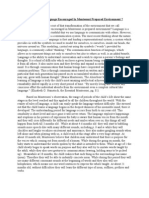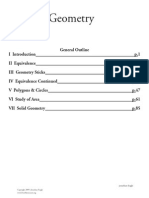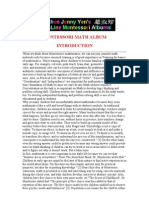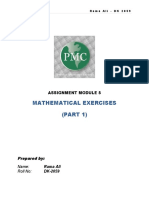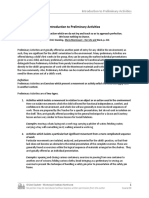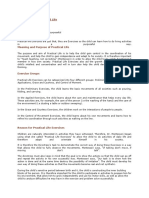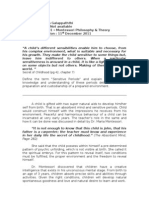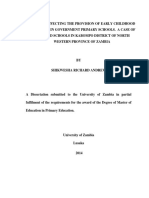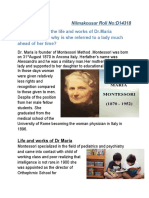0 ratings0% found this document useful (0 votes)
1K viewsChild in Family
Child in Family
Uploaded by
A B Cube PreschoolThis document is a newsletter about Montessori education containing multiple articles. It discusses how Montessori viewed the role of parents and their influence on children. It also describes a Montessori classroom activity called the mystery bag and provides tips for creating timelines of family histories.
Copyright:
© All Rights Reserved
Available Formats
Download as PDF, TXT or read online from Scribd
Child in Family
Child in Family
Uploaded by
A B Cube Preschool0 ratings0% found this document useful (0 votes)
1K views4 pagesThis document is a newsletter about Montessori education containing multiple articles. It discusses how Montessori viewed the role of parents and their influence on children. It also describes a Montessori classroom activity called the mystery bag and provides tips for creating timelines of family histories.
Original Description:
child in a family
Copyright
© © All Rights Reserved
Available Formats
PDF, TXT or read online from Scribd
Share this document
Did you find this document useful?
Is this content inappropriate?
This document is a newsletter about Montessori education containing multiple articles. It discusses how Montessori viewed the role of parents and their influence on children. It also describes a Montessori classroom activity called the mystery bag and provides tips for creating timelines of family histories.
Copyright:
© All Rights Reserved
Available Formats
Download as PDF, TXT or read online from Scribd
Download as pdf or txt
0 ratings0% found this document useful (0 votes)
1K views4 pagesChild in Family
Child in Family
Uploaded by
A B Cube PreschoolThis document is a newsletter about Montessori education containing multiple articles. It discusses how Montessori viewed the role of parents and their influence on children. It also describes a Montessori classroom activity called the mystery bag and provides tips for creating timelines of family histories.
Copyright:
© All Rights Reserved
Available Formats
Download as PDF, TXT or read online from Scribd
Download as pdf or txt
You are on page 1of 4
At a glance
Powered by AI
Some of the key principles discussed in the passages include the importance of modeling good behavior for children, respecting children, and allowing children to develop at their own pace.
Some examples of activities mentioned for creating a family timeline include using strips of paper to represent each family member's lifespan, adding photos and illustrations to important events, and creating a scrapbook with pictures and mementos of family history.
Research mentioned found that by the end of kindergarten, Montessori children performed better in reading and math, engaged in more positive social interactions, and showed more concern for fairness. By the end of elementary school, they wrote more creative essays and felt more of a sense of community in their school.
P.E.N.
To Paper:
Volume 3, Issue 7
2007
Parent Education Newsletter for Montessori Families
Articles in this issue:
The Child in the Family
Page 1:
The Child in the
Family
In her book, The Child In The
Family (1956), Maria Montessori
wrote,
Page 2:
Magnificent
Montessori
Materials: Mystery
Bag
Page 3:
Tips From
Teachers: Family
Timelines
Page 4:
Q&A
Ingrid Weland
Editor
Subscription information
or to submit an article
contact Editor at:
pentopaper@cox.net
(402) 502-9118
This newsletter is a monthly
publication available during the
school year. Subscribers may
reprint the number of copies
required for their school's use
only.
2007, I. Weland
The child is sensitive and
impressionable to such a degree
that the adult ought to monitor
everything he says and does, for
everything is literally engraved in
the childs mind. (p 40)
Most parents know that the child
observes everything a parent does.
So the role of the parent is to put
their actions behind their beliefs.
Are you living your life on a daily
basis in such a way that you would
want your child to follow? When
watching television, movies or
listening to music are you making
conscious choices to screen what is
not appropriate for your child?
Modeling also includes your
interactions with other people,
whether they are your spouse,
family members or friends. Are
you appropriately modeling how to
handle and resolve problems?
The first responsibility of the adult,
teacher or parent is to respect the
child. Respect the childs ability to
grow and develop as a human
being. Regarding the child,
Montessori felt it strange that we
commonly believe we must use
bright colors, exaggerated gestures,
and loud voices to attract his
attention (page 52). This is the
reason Montessori environments
are as natural as possible
soothing colors on the walls,
lovely, framed artwork that is
purposely placed. Montessori
Directresses approach a child to
speak to him, instead of shouting
across the room. A parent can follow
the same idealogy create a room
that is relaxing and soothing for a
child, approach a child and speak to
them to show the child respect.
The fundamental responsibility of
the Montessori education is to not
become an obstacle in the
development of the child (p 57). In
the Montessori classroom this means
the Directress lets the child select
their own work, where they want to
work and with whom. In the home
this means parents must be models of
perfection. Although not perfect, one
must do ones best to be a good
example for ones child. Think about
your values and how you are
expressing them to your child. If you
value honesty, are you living an
honest life? Do you tell little white
lies? Children hear those little white
lies and know the parent doesnt
really value honesty; just honesty
when it works in their favor. One
must always live by ones moral
code, for children see and hear
everything.
When a child joins a family it is the
parents responsibility and duty to
create the very best environment for
that child, allowing the child to
develop his own path and future.
Volume 3, Issue 6, Page 2
P.E.N. to Paper
Magnificent Montessori Materials:
Mystery Bag
The mystery bag is an interesting exercise in the early childhood classroom. The mystery bag
develops a childs intellectual curiosity, refinement of senses and their stereognostic sense (how
things feel). The mystery bag has endless possibilities regarding the type of bag (or box) as well as
objects placed inside. Following is a description of a lesson and some lesson possibilities.
The material consists of a drawstring bag that contains a few objects that usually relate in some
way. For example, a bag might contain a pinecone, an Autumn leaf and an acorn. The objects are
very different in size and texture. The child is shown the objects in the bag. The objects are placed
back in the bag and the child is asked to find the object that is rough (pinecone).
The mystery bag is frequently used to reinforce the geometric shapes the child learns in the
sensorial area of the classroom. Once the child is familiar with the names of the geometric solids,
the child is asked to put on a blindfold and pull a named geometric solid from the bag. Two
children can also complete the mystery bag activity together.
Familiar objects can also be placed in the mystery bag. Montessori Directress often place objects
that match what the class is studying. If the class is studying Australia, objects in the mystery bag
may include a kangaroo, koala bear, boomerang and other items that reflect the Australian culture.
The Mystery Bag Lesson:
1. First ensure the child knows all of the objects' names. If they do not know the name of the
object, start with the Three Period Lesson.
2. Tell the child you are going to place the objects back in the bag.
3. Place your hand in the bag and grasp an object; say the object's name.
4. Show the child what is in your hand and say, This is a ____.
5. Ask the child to pick a specific item out of the bag.
The child learns visual and tactile discrimination of form from the mystery bag lesson. The child
also increases their vocabulary.
A toddler child can complete the mystery bag work. The toddler child enjoys the variety of objects
in the mystery bag and learning the vocabulary.
P.E.N. to Paper
Volume 3, Issue 6, Page 3
Tips From Teachers: History recording family histories
The Montessori History curriculum includes timelines. Timelines provide the child with a visual
representation of history. Starting in the 3-6 year old program children participate in the creation of personal
timelines. Made in many different ways, they range from pictures of the childs life to illustrations the child
makes. The child shares their timeline with the class to show their own personal history.
Materials youll need for the Personal Timeline:
Paper, scissors, tape, glue, markers, photos
Personal Timeline:
1. A timeline can be as short as one page or as long as a wall.
2. To make a short time line, draw a vertical line down the middle of a sheet of paper.
3. Write your child's birth date on the left side of the line at the top of the page. On the right side of the
line, write the corresponding event. ("I was born!")
4. Add other important dates and events, such as when your child started to walk and talk, when
siblings were born, when your child started preschool, when you took family trips, and so on, in
chronological order.
5. To make a long time line, cut a length of paper from a large roll or tape several sheets of paper
together. Draw a horizontal line across the middle of the banner.
6. Write the dates and events of your child's life from left to right.
7. Glue on photos or let your child illustrate each event.
8. Hang the time line in your child's room and add to it occasionally.
Family Timeline:
The family timeline can be represented by lined paper cut into strips (legal pads work well). The child
counts one line on the paper strip for each year of each family members life. So, Dad might have a strip
with 32 lines. Mom may have a strip with 31 lines. The child would have a timeline that has 3 strips and an
older sibling would have a strip of paper with 7 lines. The visual representation is very interesting for the
child and it also helps them to see their place in the family. The child also sees the passage of time as they
add a strip of paper from year to year.
Family History Albums:
Scrapbooking has taken off tremendously in the past few decades. This craft is a wonderful way to work
with your child to create an on-going family history. Your album can be simple pictures slipped into a book,
elaborate scrapbook pages or completely crafted on your computer. If you are interested in creating a family
history album with your child a great place to start is your local craft store or scrapbook store. Many offer
classes to help you begin. You can also find plenty of resources on the internet if you are interested.
___________________________________________________________________ ____________________
Maria Montessori in What You Should Know About Your Child: For a growing organism growth itself is
happiness.
????????_______________________________________________________________________________________
P.E.N. to Paper
Volume 3, Issue 6, Page 4
Questions from Montessori Parents
Q: What are the advantages of
a Montessori education? How
long should I keep my child in
a Montessori program? What
resources can you recommend?
What research has been
conducted to prove the benefits
of the program?
A:
There are many advantages of a
Montessori education. Here are
some advantages that were
recently documented in
periodical Science based on
research by Angeline Lillard
and Nicole Else-Quest.
By the end of Kindergarten,
Montessori children performed
better in reading and
mathematics on standardized
tests, engaged in more positive
interactions on the playground,
and showed more concern for
fairness and justice. At the end
of elementary school they
wrote more creative sentences
and complex essays, reported
feeling more of a sense of
community with their school.
How long you keep your child
in a Montessori program is
dependent on many factors
including how successful your
child is in their program, other
educational opportunities and
financial considerations. The
best suggestion is to fully
understand the choices you
have available to you. Tour the
schools you are considering,
talk to other parents who have
children attending the various
programs. Talk to the children
attending the school if possible.
What are you listening for? How
does the child feel about their
educational experience? What
kinds of things are they studying
and how much control they feel
they have over their learning?
Angline Lillards book, The
Science Behind the Genius is one
recent example of Montessori
education pedagogy and
research. Lillard does an
excellent job relating Montessori
ideals and finding research, not
all particular to Montessori
education, which supports the
Montessori Methodology.
You might also like
- The Four Planes of Education Maria MontessoriDocument16 pagesThe Four Planes of Education Maria Montessorimariposa5100% (1)
- Human TendenciesDocument2 pagesHuman TendenciesRushika Perera Nugawela50% (6)
- The Montessori Way PDFDocument276 pagesThe Montessori Way PDFDiego IcazaNo ratings yet
- How Is Language Encouraged in A Montessori Prepared EnviromentDocument5 pagesHow Is Language Encouraged in A Montessori Prepared Enviromentluisxav9086% (7)
- History Question Charts HelenaDocument6 pagesHistory Question Charts Helenahelenareid100% (2)
- Montessori Pedagogy - Sensitive Periods in The First Plane of DevelopmentDocument6 pagesMontessori Pedagogy - Sensitive Periods in The First Plane of Developmenttopsy-turvyNo ratings yet
- The Absorbent MindDocument1 pageThe Absorbent Mindkarl symondsNo ratings yet
- FastrackidsDocument25 pagesFastrackidspascal rosas100% (1)
- Sensitive Periods C38Document11 pagesSensitive Periods C38Gavi NnamdiNo ratings yet
- C Montessori Cosmic EducationDocument14 pagesC Montessori Cosmic EducationNurul Dzikrillah100% (1)
- Montessori ParadigmDocument100 pagesMontessori ParadigmMihaela AndreeaNo ratings yet
- Human Needs and TendenciesDocument9 pagesHuman Needs and TendenciesHeidi Quiring0% (1)
- The Montessori Red Rods Lesson Activity MontessoriHelperDocument3 pagesThe Montessori Red Rods Lesson Activity MontessoriHelperLoredana Românu Miloş100% (1)
- Directing The Montessori Children's HouseDocument89 pagesDirecting The Montessori Children's HouseMaria ZaharievaNo ratings yet
- Technology in MontessoriDocument9 pagesTechnology in MontessoriṦafia NazNo ratings yet
- Geometry AlbumDocument107 pagesGeometry AlbumMersi Ta100% (8)
- A Delicate Task: Teaching and Learning on a Montessori PathFrom EverandA Delicate Task: Teaching and Learning on a Montessori PathNo ratings yet
- The Human TendenciesDocument10 pagesThe Human TendenciesSaraswathy VinayakamurthyNo ratings yet
- Maria Montessori's The Secret of Childhood' - Understanding The Montessori Method - Genesis, Development and CritiqueDocument16 pagesMaria Montessori's The Secret of Childhood' - Understanding The Montessori Method - Genesis, Development and CritiqueLaura100% (2)
- Montessori Move Case Study Montessori Pedagogical Instructional Principles Implications Community College Course Graduates Career PathsDocument109 pagesMontessori Move Case Study Montessori Pedagogical Instructional Principles Implications Community College Course Graduates Career Paths123_scNo ratings yet
- Montessori AlbumDocument382 pagesMontessori AlbumDomina Sable100% (5)
- Sensorial Activity Lessons For ToddlersDocument19 pagesSensorial Activity Lessons For ToddlersMarta Candela LapeñaNo ratings yet
- Example and Definition: Sensitive Periods Is A Term Developed by The Dutch Geneticist Hugo de Vries and Later UsedDocument10 pagesExample and Definition: Sensitive Periods Is A Term Developed by The Dutch Geneticist Hugo de Vries and Later UsedMehakBatla100% (1)
- Maria Montessori Described The Sensorial Materials As TheDocument2 pagesMaria Montessori Described The Sensorial Materials As TheJirasuta Sakulkittithumrong75% (4)
- Observation 1987 London UpdatedDocument3 pagesObservation 1987 London UpdatedAleksandraNo ratings yet
- Evaluating Montessori EducationDocument2 pagesEvaluating Montessori EducationDaniela RosmarinNo ratings yet
- Primary Montessori Intervals BasicDocument15 pagesPrimary Montessori Intervals BasicSilvia VictoriaNo ratings yet
- Introduction To MontessoriDocument41 pagesIntroduction To MontessoriHadia Ab HadiNo ratings yet
- MontessoriDocument5 pagesMontessoriNassar HayatNo ratings yet
- The NAMTA Journal - Vol. 39, No. 2 - Spring 2014: Ginni SackettDocument20 pagesThe NAMTA Journal - Vol. 39, No. 2 - Spring 2014: Ginni SackettSaeed Ahmed BhattiNo ratings yet
- Elementary Education Formal Observation FormDocument6 pagesElementary Education Formal Observation Formapi-355280831No ratings yet
- The Path To Normalization Finding and Measuring The Essentials of The Montessori MethodDocument49 pagesThe Path To Normalization Finding and Measuring The Essentials of The Montessori MethodxxxxxxNo ratings yet
- Oral Language ExercisesDocument21 pagesOral Language ExercisesAlishba Faixan0% (1)
- Baker Q & A 0n ObservationDocument8 pagesBaker Q & A 0n ObservationRahulNo ratings yet
- ElementaryDocument8 pagesElementaryapi-520634141No ratings yet
- AMI Montessori Observation Refresher 2019Document10 pagesAMI Montessori Observation Refresher 2019Aleksandra100% (1)
- Montessori QuotesDocument8 pagesMontessori Quotesbentarigan77100% (1)
- Ami School Standards 7092Document2 pagesAmi School Standards 7092Dunja Kojić ŠeguljevNo ratings yet
- Montessori Discipline and ObedienceDocument4 pagesMontessori Discipline and ObedienceDeric Soon100% (1)
- Define The Term Sensitive PeriodsDocument3 pagesDefine The Term Sensitive PeriodsBéla Soltész100% (4)
- Group Work in The Montessori ElementaryDocument4 pagesGroup Work in The Montessori ElementaryanaNo ratings yet
- Introduction To Practical LifeDocument24 pagesIntroduction To Practical Lifenabila635493No ratings yet
- Spontaneous Activity in Education by Montessori, Maria, 1870-1952Document164 pagesSpontaneous Activity in Education by Montessori, Maria, 1870-1952Gutenberg.org100% (5)
- Botany Activities PDFDocument52 pagesBotany Activities PDFTania Babcinetchi100% (1)
- 2.1.5 The Knobless CylindersDocument3 pages2.1.5 The Knobless CylindersAdhirajNo ratings yet
- The Geometry CabinetDocument19 pagesThe Geometry Cabinetdanu_huNo ratings yet
- Inside The Montessori ClassroomDocument18 pagesInside The Montessori ClassroomZandria Camille Delos SantosNo ratings yet
- SensorialDocument6 pagesSensorialPatrick DaniardNo ratings yet
- 3period LessonokprintDocument3 pages3period LessonokprintFresia MonterrubioNo ratings yet
- Montessori SensorialDocument12 pagesMontessori Sensorialavuma22100% (2)
- Assignment Module 5Document27 pagesAssignment Module 5Salman Hyder RizviNo ratings yet
- Decimal Checkerboard LessonDocument8 pagesDecimal Checkerboard Lessonapi-245433615No ratings yet
- Maria Montessori Cosmic StoriesDocument14 pagesMaria Montessori Cosmic StoriesNature's Will MontessoriNo ratings yet
- Introduction To Preliminary Activities C38Document2 pagesIntroduction To Preliminary Activities C38Marinella PerezNo ratings yet
- Introduction To Practical LifeDocument9 pagesIntroduction To Practical LifeQasim Ali KhanNo ratings yet
- Question 01Document15 pagesQuestion 01Rashid Hameed90% (10)
- SensorialDocument10 pagesSensorialMonwei YungNo ratings yet
- NAMTA2018 Summer Journal FINALDocument114 pagesNAMTA2018 Summer Journal FINALpetry100% (1)
- Final AssignmentDocument8 pagesFinal Assignmentshyamila_galappathth75% (4)
- Biographical Note On Maria Montessori Author Montessori School of OceansideDocument20 pagesBiographical Note On Maria Montessori Author Montessori School of OceansideCivil CourtNo ratings yet
- Course 37 Practical Life Presentation Outlines 5kb2Document32 pagesCourse 37 Practical Life Presentation Outlines 5kb2Kreativ MontessoriNo ratings yet
- Lesson 3Document20 pagesLesson 3Kassandra KayNo ratings yet
- Assignment: Name: Shamaila Kiran Roll No:D16633Document38 pagesAssignment: Name: Shamaila Kiran Roll No:D16633shamaila kiranNo ratings yet
- Milestones of Maria MontessoriDocument2 pagesMilestones of Maria MontessoriThalia Jemmina HortezanoNo ratings yet
- Module 1 Assignment Roll No.D15304Document12 pagesModule 1 Assignment Roll No.D15304Muniba Farid100% (2)
- Role of Montessori TeacherDocument4 pagesRole of Montessori TeacherShazia Saleem75% (4)
- As22 Ece21 1Document7 pagesAs22 Ece21 1Michelle SalvadorNo ratings yet
- Nurturing NumbersDocument18 pagesNurturing NumbersAlina MargaritNo ratings yet
- Bài 1 Modul 5 PDFDocument12 pagesBài 1 Modul 5 PDFMontessory Nhật KýNo ratings yet
- Montessori QuotesDocument8 pagesMontessori Quotesbentarigan77100% (1)
- Lincolnshire Montessori April NewsDocument2 pagesLincolnshire Montessori April NewsSylvia ArcherNo ratings yet
- Why Focusing On Grades Is A Barrier To Learning - Harvard Business Publishing EducationDocument9 pagesWhy Focusing On Grades Is A Barrier To Learning - Harvard Business Publishing Educationaqsa imranNo ratings yet
- Language ImportanceDocument4 pagesLanguage Importanceahmad saleemNo ratings yet
- Lesson 2 - (1) Montessori ModelDocument29 pagesLesson 2 - (1) Montessori ModelClarisse VasquezNo ratings yet
- Early Education EffortsDocument44 pagesEarly Education EffortsVictoria AntonetteNo ratings yet
- NormalisasiDocument14 pagesNormalisasijumrotul.ulahlfiNo ratings yet
- History of MontessoriDocument19 pagesHistory of MontessoriRazi AbbasNo ratings yet
- Educ 200 RequirementsDocument12 pagesEduc 200 RequirementsGhlends Alarcio GomezNo ratings yet
- 8th Assignment PMCDocument12 pages8th Assignment PMCMisbah Amjad100% (1)
- The Three Period LessonDocument1 pageThe Three Period LessonĶanwal MoinNo ratings yet
- Thesis Early PDFDocument108 pagesThesis Early PDFryanNo ratings yet
- Exploring The Montessori Way: A Comprehensive Guide To Montessori Educational PhilosophyDocument157 pagesExploring The Montessori Way: A Comprehensive Guide To Montessori Educational PhilosophyKhritish SwargiaryNo ratings yet
- ProposalDocument7 pagesProposalsunnyNo ratings yet
- Montessori Elementary Philosophy Author Angela MurrayDocument11 pagesMontessori Elementary Philosophy Author Angela MurrayCivil CourtNo ratings yet
- Assignment 1 PMCDocument18 pagesAssignment 1 PMCwhen i writeNo ratings yet
- Introduction To Montessori Education0001 PDFDocument5 pagesIntroduction To Montessori Education0001 PDFFatushe JasharajNo ratings yet
- Montessori Method of EducationDocument12 pagesMontessori Method of EducationCelina BarriosNo ratings yet
- Kidken Catalog - 2024-2025Document42 pagesKidken Catalog - 2024-2025dinukebabiNo ratings yet
- AcEPT Package SoalDocument31 pagesAcEPT Package SoalNisa Nisa100% (1)



